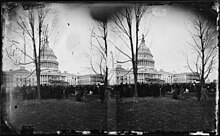45th United States Congress
| 45th United States Congress | |
|---|---|
|
44th ←
→ 46th
|
|

United States Capitol (1869)
|
|
| March 4, 1877 – March 4, 1879 | |
| Senate President | William A. Wheeler (R) |
| Senate Pres. pro tem: | Thomas W. Ferry (R) |
| House Speaker: | Samuel J. Randall (D) |
| Members: | 76 Senators 293 Representatives 8 Non-voting members |
| Senate Majority: | Republican |
| House Majority: | Democratic |
| Sessions | |
|
Special: March 5, 1877 – March 17, 1877 1st: October 15, 1877 – December 3, 1877 2nd: December 3, 1877 – June 20, 1878 3rd: December 2, 1878 – March 3, 1879 |
|
The Forty-fifth United States Congress was a meeting of the legislative branch of the United States federal government, consisting of the United States Senate and the United States House of Representatives. It met in Washington, D.C. from March 4, 1877 to March 4, 1879, during the first two years of Rutherford Hayes's presidency. The apportionment of seats in the House of Representatives was based on the Ninth Census of the United States in 1870. The Senate had a Republican majority, and the House had a Democratic majority.
The 45th Congress remained politically divided between a Democratic House and Republican Senate. President Hayes vetoed an Army appropriations bill from the House which would have ended Reconstruction and prohibited the use of federal troops to protect polling stations in the former Confederacy. Striking back, Congress overrode another of Hayes’s vetoes and enacted the Bland-Allison Act that required the purchase and coining of silver. Congress also approved a generous increase in pension eligibility for Northern Civil War veterans.
The count below identifies party affiliations at the beginning of the first session of this Congress, and includes members from vacancies and newly admitted states, when they were first seated. Changes resulting from subsequent replacements are shown below in the "Changes in membership" section.
During this Congress, two Senate seats and one House seat were added for the new state, Colorado.
This list is arranged by chamber, then by state. Senators are listed in order of seniority, and Representatives are listed by district.
Senators were elected by the state legislatures every two years, with one-third beginning new six-year terms with each Congress. Preceding the names in the list below are Senate class numbers, which indicate the cycle of their election. In this Congress, Class 1 meant their term began in the last Congress, requiring reelection in 1880; Class 2 meant their term began in this Congress, requiring reelection in 1882; and Class 3 meant their term ended in this Congress, requiring reelection in 1878.
...
Wikipedia
